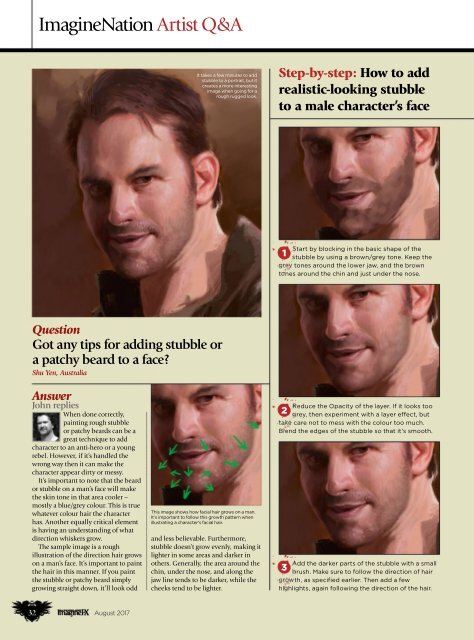i-m-a-g-i-n-efx-august
Create successful ePaper yourself
Turn your PDF publications into a flip-book with our unique Google optimized e-Paper software.
ImagineNation Artist Q&A<br />
It takes a few minutes to add<br />
stubble to a portrait, but it<br />
creates a more interesting<br />
image when going for a<br />
rough rugged look.<br />
Step-by-step: How to add<br />
realistic-looking stubble<br />
to a male character’s face<br />
Start by blocking in the basic shape of the<br />
1<br />
stubble by using a brown/grey tone. Keep the<br />
grey tones around the lower jaw, and the brown<br />
tones around the chin and just under the nose.<br />
Question<br />
Got any tips for adding stubble or<br />
a patchy beard to a face?<br />
Shu Yen, Australia<br />
Answer<br />
John replies<br />
When done correctly,<br />
painting rough stubble<br />
or patchy beards can be a<br />
great technique to add<br />
character to an anti-hero or a young<br />
rebel. However, if it’s handled the<br />
wrong way then it can make the<br />
character appear dirty or messy.<br />
It’s important to note that the beard<br />
or stubble on a man’s face will make<br />
the skin tone in that area cooler –<br />
mostly a blue/grey colour. This is true<br />
whatever colour hair the character<br />
has. Another equally critical element<br />
is having an understanding of what<br />
direction whiskers grow.<br />
The sample image is a rough<br />
illustration of the direction hair grows<br />
on a man’s face. It’s important to paint<br />
the hair in this manner. If you paint<br />
the stubble or patchy beard simply<br />
growing straight down, it’ll look odd<br />
This image shows how facial hair grows on a man.<br />
It’s important to follow this growth pattern when<br />
illustrating a character’s facial hair.<br />
and less believable. Furthermore,<br />
stubble doesn’t grow evenly, making it<br />
lighter in some areas and darker in<br />
others. Generally, the area around the<br />
chin, under the nose, and along the<br />
jaw line tends to be darker, while the<br />
cheeks tend to be lighter.<br />
Reduce the Opacity of the layer. If it looks too<br />
2<br />
grey, then experiment with a layer effect, but<br />
take care not to mess with the colour too much.<br />
Blend the edges of the stubble so that it’s smooth.<br />
Add the darker parts of the stubble with a small<br />
3<br />
brush. Make sure to follow the direction of hair<br />
growth, as specified earlier. Then add a few<br />
highlights, again following the direction of the hair.<br />
32 August 2017


















